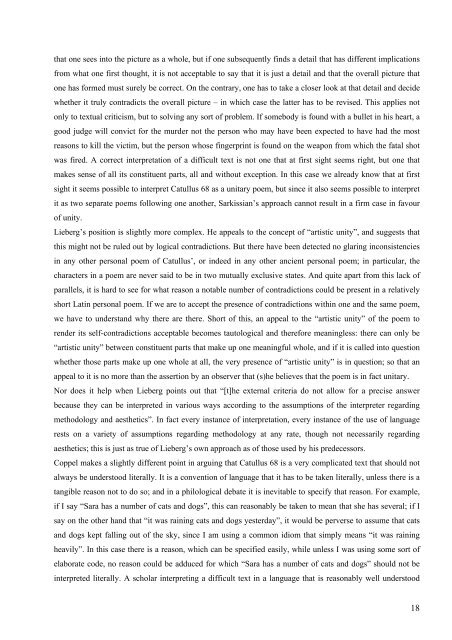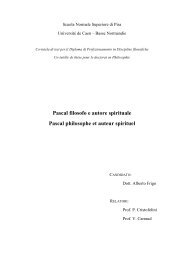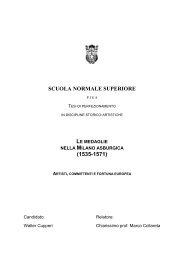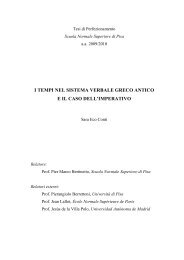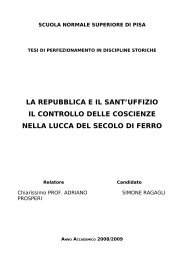CATULLUS 68 - Scuola Normale Superiore
CATULLUS 68 - Scuola Normale Superiore
CATULLUS 68 - Scuola Normale Superiore
Create successful ePaper yourself
Turn your PDF publications into a flip-book with our unique Google optimized e-Paper software.
that one sees into the picture as a whole, but if one subsequently finds a detail that has different implications<br />
from what one first thought, it is not acceptable to say that it is just a detail and that the overall picture that<br />
one has formed must surely be correct. On the contrary, one has to take a closer look at that detail and decide<br />
whether it truly contradicts the overall picture – in which case the latter has to be revised. This applies not<br />
only to textual criticism, but to solving any sort of problem. If somebody is found with a bullet in his heart, a<br />
good judge will convict for the murder not the person who may have been expected to have had the most<br />
reasons to kill the victim, but the person whose fingerprint is found on the weapon from which the fatal shot<br />
was fired. A correct interpretation of a difficult text is not one that at first sight seems right, but one that<br />
makes sense of all its constituent parts, all and without exception. In this case we already know that at first<br />
sight it seems possible to interpret Catullus <strong>68</strong> as a unitary poem, but since it also seems possible to interpret<br />
it as two separate poems following one another, Sarkissian’s approach cannot result in a firm case in favour<br />
of unity.<br />
Lieberg’s position is slightly more complex. He appeals to the concept of “artistic unity”, and suggests that<br />
this might not be ruled out by logical contradictions. But there have been detected no glaring inconsistencies<br />
in any other personal poem of Catullus’, or indeed in any other ancient personal poem; in particular, the<br />
characters in a poem are never said to be in two mutually exclusive states. And quite apart from this lack of<br />
parallels, it is hard to see for what reason a notable number of contradictions could be present in a relatively<br />
short Latin personal poem. If we are to accept the presence of contradictions within one and the same poem,<br />
we have to understand why there are there. Short of this, an appeal to the “artistic unity” of the poem to<br />
render its self-contradictions acceptable becomes tautological and therefore meaningless: there can only be<br />
“artistic unity” between constituent parts that make up one meaningful whole, and if it is called into question<br />
whether those parts make up one whole at all, the very presence of “artistic unity” is in question; so that an<br />
appeal to it is no more than the assertion by an observer that (s)he believes that the poem is in fact unitary.<br />
Nor does it help when Lieberg points out that “[t]he external criteria do not allow for a precise answer<br />
because they can be interpreted in various ways according to the assumptions of the interpreter regarding<br />
methodology and aesthetics”. In fact every instance of interpretation, every instance of the use of language<br />
rests on a variety of assumptions regarding methodology at any rate, though not necessarily regarding<br />
aesthetics; this is just as true of Lieberg’s own approach as of those used by his predecessors.<br />
Coppel makes a slightly different point in arguing that Catullus <strong>68</strong> is a very complicated text that should not<br />
always be understood literally. It is a convention of language that it has to be taken literally, unless there is a<br />
tangible reason not to do so; and in a philological debate it is inevitable to specify that reason. For example,<br />
if I say “Sara has a number of cats and dogs”, this can reasonably be taken to mean that she has several; if I<br />
say on the other hand that “it was raining cats and dogs yesterday”, it would be perverse to assume that cats<br />
and dogs kept falling out of the sky, since I am using a common idiom that simply means “it was raining<br />
heavily”. In this case there is a reason, which can be specified easily, while unless I was using some sort of<br />
elaborate code, no reason could be adduced for which “Sara has a number of cats and dogs” should not be<br />
interpreted literally. A scholar interpreting a difficult text in a language that is reasonably well understood<br />
18


